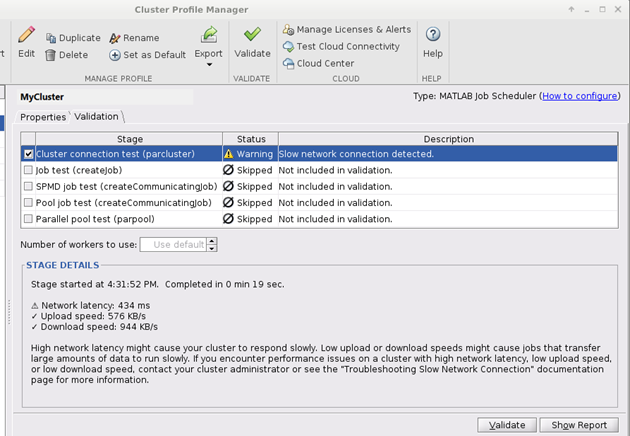Troubleshoot Slow Network Connection
Issue
Several factors can affect the responsiveness of the connection between a client and a MATLAB® Job Scheduler cluster. When you validate a cluster profile, the first stage is a cluster connection test that the software uses to assess the quality and performance of your connection to a MATLAB Job Scheduler cluster. This test measures the network latency, upload speed, and download speed to identify potential issues that can affect the connection to the cluster.
If the software detects an issue with the network connection, the stage status displays a warning and the description displays the message:
Slow network connection detected

Possible Solutions
Identify and eliminate the factors that contribute to high latency, slow upload or download speed issues.
High Network Latency
Network latency refers to the time it takes for a data packet to travel from your MATLAB client to the cluster and back. It is typically measured in milliseconds (ms). During the cluster connection test, a latency of more than 300 ms results in a low latency stage warning.
Low latency indicates a fast and responsive connection to the cluster. High latency can lead to delays during data transmission and slower response times. This can manifest as slow or unresponsive cluster interactions, which are particularly noticeable when you use interactive parallel pools. While high latency can be acceptable for certain applications, it can significantly impact real-time interactions.
Use this list to identify the factors that contribute to high latency and take appropriate measures to eliminate these factors. You can contact your internet service provider or network administrator for assistance.
Overcrowded or overloaded network.
Network interference or packet loss.
Poor network infrastructure.
Long physical distance between the MATLAB client and the cluster.
Low Upload Speed
Upload speed refers to the rate at which your device transmits data to the cluster. It is measured in kilobits per second (KB/s). During the cluster connection test, an upload speed of less than 100 KB/s results in a low upload speed stage warning.
Fast upload speeds indicate faster data transfer capabilities and supports smooth uploading of files and data to the cluster. Poor upload speed can slow down the process of uploading files or data to the cluster and affect the performance of real-time interactions with the cluster.
If your workflow does not involve data uploads, often a slow upload speed does not affect your interactions with the cluster. However, if you have a workflow that does involve uploading data to the cluster, use this list to identify the factors that contribute to low upload speed and take appropriate measures to eliminate these factors. You can contact your internet service provider or network administrator for assistance.
Limited bandwidth provided by your internet service provider (ISP).
Network congestion and high usage during peak hours.
Network interference or poor signal strength.
Hardware limitations of your device.
Low Download Speed
Download speed refers to the rate at which your device receives data from the cluster. Like upload speed, it is measured in kilobits per second (KB/s). During the cluster connection test, a download speed of less than 100 KB/s results in a low upload speed stage warning.
A fast download speed indicates faster and smooth downloads of data. A poor download speed can slow down the process of receiving data from the cluster.
Use this list to identify the factors that contribute to low download speed and take appropriate measures to eliminate these factors. You can contact your internet service provider or network administrator for assistance.
Limited bandwidth provided by your internet service provider (ISP).
Network congestion and high usage during peak hours.
Network interference or poor signal strength.
Cluster hardware limitations or bottlenecks.